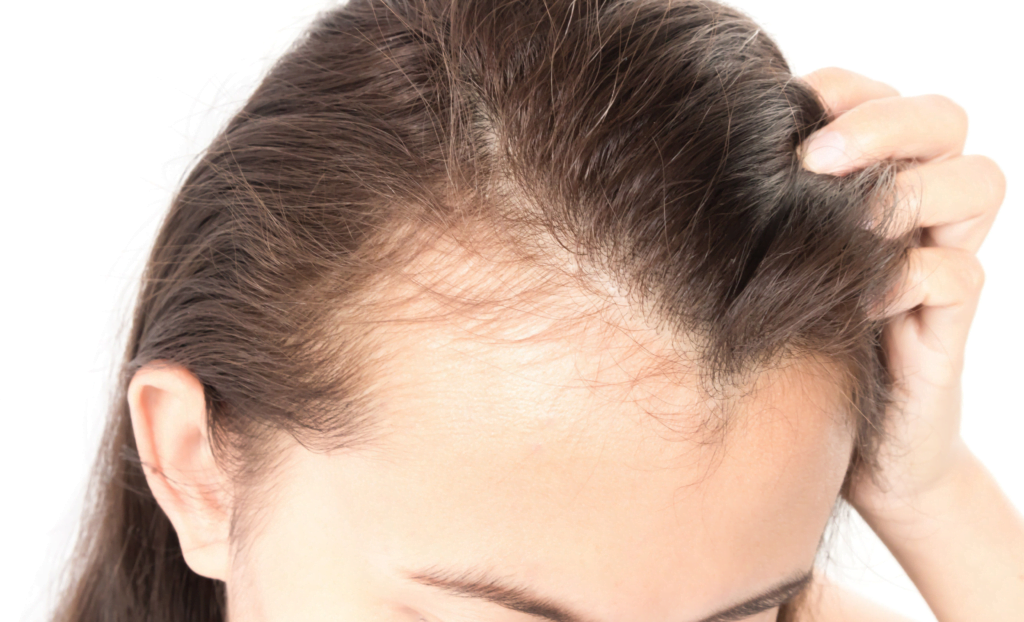Is M Shaped Hairline Normal? A hairline is the line of hair that grows on the forehead, usually above the eyebrows. The shape and position of the hairline can vary from person to person, depending on factors such as genetics, age, hormones, and hair loss. Some people have a straight hairline, while others have a curved, V-shaped, or M-shaped hairline.
An M-shaped hairline, also known as a widow’s peak, is a type of receding hairline that forms a point in the center of the forehead. It is more common in men than in women, and it can be a sign of male pattern baldness, a hereditary condition that causes hair follicles to shrink and stop producing hair. However, not all M-shaped hairlines are caused by hair loss. Some people are born with an M-shaped hairline, and it can also be a normal part of aging.

Table of Contents
Is M Shaped Hairline Normal?
There is no definitive answer to whether an M-shaped hairline is normal or not. It depends on the individual’s preferences, expectations, and self-image. Some people may like their M-shaped hairline and consider it a distinctive feature of their appearance. Others may dislike their M-shaped hairline and feel insecure or unhappy about it. There is no right or wrong way to feel about your hairline, as long as it does not affect your mental health or quality of life.
However, if you are concerned about your M-shaped hairline, you may want to consult a dermatologist or a trichologist, a specialist in hair and scalp disorders. They can examine your hairline and determine the cause and severity of your hair loss, if any. They can also advise you on the best treatment options for your condition, such as medications, topical solutions, laser therapy, or hair transplantation.
What is Hairline Lowering Surgery?
If you are not happy with your hairline, you may consider hairline lowering surgery, also known as forehead reduction, scalp advancement, or frontal hairline advancement. This is a cosmetic procedure that lowers the hairline by removing a strip of skin from the forehead and pulling the scalp forward. The result is a shorter forehead and a more balanced facial proportion.
Hairline lowering surgery can be performed on both men and women, but it is more suitable for those who have a high or receding hairline, a thick and dense hair, and a good scalp elasticity. It is not recommended for those who have a thin or fine hair, a low or irregular hairline, or a history of keloid or hypertrophic scarring.
How is Hairline Lowering Surgery Performed?
Hairline lowering surgery is usually performed under local anesthesia with sedation or general anesthesia, depending on the patient’s preference and the surgeon’s recommendation. The surgery takes about one to two hours, and it involves the following steps:
- The surgeon marks the new hairline and the incision line on the forehead, following the natural shape and direction of the hair.
- The surgeon makes a horizontal incision along the incision line, which is usually hidden within the hair or at the hairline. The incision may extend from ear to ear, or it may be shorter, depending on the amount of skin to be removed.
- The surgeon removes a strip of skin from the forehead, usually about 2 to 3 cm wide, and lifts the scalp from the underlying tissue.
- The surgeon pulls the scalp forward and downward, and sutures it to the remaining skin on the forehead, creating a new hairline.
- The surgeon closes the incision with stitches or staples, and covers it with a bandage or a surgical cap.
What are the Benefits of Hairline Lowering Surgery?
Hairline lowering surgery can offer several benefits for those who are unhappy with their hairline, such as:
- A more youthful and feminine appearance, especially for women who have a high or masculine hairline.
- A more harmonious and symmetrical facial proportion, especially for those who have a large or prominent forehead.
- A more natural and permanent result, compared to other methods of hairline correction, such as hairpieces, wigs, or microblading.
- A more confident and positive self-image, as well as a higher self-esteem and social acceptance.
What are the Risks and Complications of Hairline Lowering Surgery?
As with any surgery, hairline lowering surgery carries some risks and complications, such as:
- Scarring: The incision may leave a visible scar on the forehead, which can be noticeable when the hair is wet, parted, or pulled back. The scar may fade over time, but it may not disappear completely. Some people may develop keloid or hypertrophic scars, which are raised, red, or dark scars that can be itchy or painful.
- Hair loss: The surgery may cause temporary or permanent hair loss along the incision line or the new hairline, due to the trauma or tension on the scalp. The hair loss may be more noticeable in those who have a thin or fine hair, or a history of hair loss.
- Nerve damage: The surgery may damage the nerves that supply the forehead, eyebrows, or scalp, resulting in numbness, tingling, or reduced sensation. The nerve damage may be temporary or permanent, and it may affect the facial expression or movement.
- Infection: The surgery may cause infection in the wound or the scalp, which can lead to swelling, redness, pain, fever, or pus. The infection may require antibiotics or additional surgery to treat.
- Unnatural appearance: The surgery may create an unnatural or artificial appearance of the hairline, especially if the new hairline is too low, too straight, or too symmetrical. The surgery may also alter the shape or position of the eyebrows, which can affect the facial expression or balance.
How to Prepare for Hairline Lowering Surgery?
If you decide to undergo hairline lowering surgery, you should prepare yourself physically and mentally for the procedure. Here are some tips on how to prepare for hairline lowering surgery:
- Choose a qualified and experienced surgeon who specializes in hairline lowering surgery. Ask for before and after photos of their previous patients, and discuss your expectations and goals with them. Make sure you understand the risks and benefits of the surgery, and the possible outcomes and complications.
- Stop smoking at least two weeks before the surgery, as smoking can impair the healing process and increase the risk of infection and scarring.
- Avoid taking aspirin, ibuprofen, or other blood-thinning medications or supplements at least one week before the surgery, as they can increase the bleeding and bruising during and after the surgery.
- Wash your hair with a mild shampoo the night before or the morning of the surgery, and do not apply any hair products, such as gel, spray, or dye.
- Arrange for someone to drive you to and from the surgery, and to stay with you for the first 24 hours after the surgery, as you may feel groggy or dizzy from the anesthesia or sedation.
- Pack a bag with some essentials, such as your identification, insurance card, medication, comfortable clothes, pillow, and ice packs.
How to Recover from Hairline Lowering Surgery?
The recovery from hairline lowering surgery may vary from person to person, depending on the extent of the surgery, the healing ability, and the post-operative care. Here are some general guidelines on how to recover from hairline lowering surgery:
- Follow the surgeon’s instructions on how to care for the wound, such as cleaning, dressing, and applying ointment or antibiotic cream. Keep the wound dry and clean, and avoid touching or scratching it.
- Take the prescribed painkillers, antibiotics, or anti-inflammatory drugs as directed by the surgeon, and avoid taking any other medications or supplements without consulting the surgeon.
- Apply ice packs or cold compresses to the forehead and scalp for the first 48 hours after the surgery, to reduce the swelling, bruising, and discomfort. Elevate your head with pillows when lying down, and avoid bending or stooping.
- Avoid washing your hair for the first week after the surgery, or until the surgeon removes the stitches or staples. When washing your hair, use a gentle shampoo and lukewarm water, and avoid rubbing or pulling the hair. Pat the hair dry with a soft towel, and do not use a hairdryer, curling iron, or straightener.
- Avoid strenuous activities, such as exercise, sports, or lifting heavy objects, for at least two weeks after the surgery, or until the surgeon clears you. Resume your normal activities gradually, and listen to your body.
- Avoid sun exposure, heat, or cold for at least six months after the surgery, as they can affect the healing and scarring of the wound. Wear a hat, scarf, or sunscreen when going outdoors, and protect your hair from wind or dust.
- Be patient and realistic with the results of the surgery, as they may take several months to become apparent. The swelling and bruising may subside within a few weeks, but the scar may take up to a year to fade. The hair may grow back slowly, and it may have a different texture or color. The final outcome of the surgery may depend on the individual’s hair quality, density, and growth pattern.
Why Choose Turkey for Hairline Lowering Surgery?
If you are looking for a destination to have hairline lowering surgery, you may want to consider Turkey as an option. Turkey is one of the leading countries in the world for medical tourism, especially for cosmetic procedures such as hairline lowering surgery. Here are some of the reasons why you should choose Turkey for hairline lowering surgery:
- Quality: Turkey has a high standard of medical care, with modern facilities, advanced technology, and qualified surgeons. Many Turkish surgeons are internationally trained and certified, and they have extensive experience in hairline lowering surgery. They also follow the latest techniques and trends in the field, and they can customize the surgery according to the patient’s needs and preferences.
- Cost: Turkey offers affordable prices for hairline lowering surgery, compared to other countries in Europe or North America. The average cost of hairline lowering surgery in Turkey is around $3,000, while the same procedure can cost up to $10,000 in the US or $8,000 in the UK. The low cost of hairline lowering surgery in Turkey does not compromise the quality, as it reflects the lower cost of living and labor in the country. Moreover, the cost of hairline lowering surgery in Turkey usually includes the consultation, anesthesia, surgery, hospital stay, medication, and aftercare, as well as the travel and accommodation expenses.
- Vacation: Turkey is a beautiful and diverse country, with a rich history, culture, and nature. You can enjoy a relaxing and enjoyable vacation in Turkey, before or after your hairline lowering surgery. You can visit the stunning attractions of Istanbul, the capital city of Turkey, such as the Hagia Sophia, the Blue Mosque, the Grand Bazaar, and the Bosphorus. You can also explore the other regions of Turkey, such as the Mediterranean coast, where you can find the city of Antalya, a popular destination for sun, sea, and sand. Antalya is also home to some of the best clinics and hospitals for hairline lowering surgery, where you can combine your treatment with a holiday.
- Recovery: Turkey offers a comfortable and convenient recovery for hairline lowering surgery patients, with a warm and sunny climate, a friendly and hospitable people, and a delicious and healthy cuisine. You can recover from your hairline lowering surgery in a private and peaceful environment, with the support and guidance of the medical staff and the surgeon. You can also enjoy the natural and cultural beauty of Turkey, which can help you heal faster and better.

Conclusion
An M-shaped hairline is a type of hairline that forms a point in the center of the forehead. It can be a normal variation of the hairline, or it can be a sign of hair loss. If you are not happy with your M-shaped hairline, you may consider hairline lowering surgery, a cosmetic procedure that lowers the hairline by removing a strip of skin from the forehead and pulling the scalp forward. Hairline lowering surgery can improve your appearance, confidence, and self-esteem, but it also has some risks and complications, such as scarring, hair loss, nerve damage, infection, and unnatural appearance. Therefore, you should consult a dermatologist or a trichologist before deciding to have hairline lowering surgery, and choose a qualified and experienced surgeon who can perform the surgery safely and effectively. You may also want to choose Turkey as your destination for hairline lowering surgery, as Turkey offers quality, cost, vacation, and recovery advantages for hairline lowering surgery patients. Turkey is one of the best countries in the world for medical tourism, especially for cosmetic procedures such as hairline lowering surgery.
Visit the Dr.MFO Instagram profile for examples of successful Surgeries. Contact for free consultation.





